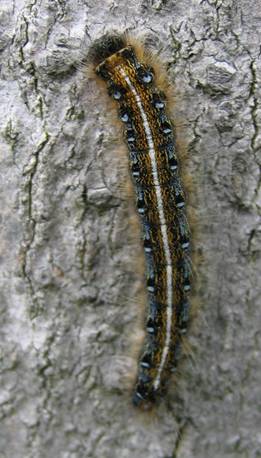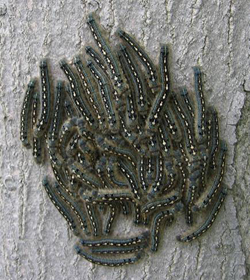DACF Home → Bureaus & Programs → Maine Forest Service → Forest Health & Monitoring → Forest Pest Index → Tent Caterpillars
TENT CATERPILLARS

Photo: Maine Forest Service, Forest Health & Monitoring, Photo Collection
Eastern Tent Caterpillar, Malacosoma americanum (F.)
Webbings or tents in the crotches of wild cherry and apple trees in May along roadsides, hedgerows, and edges of fields indicate the presence of the eastern tent caterpillar. These tents are first noticed as the young caterpillars hatch and the buds begin to open in early May. As the larvae grow, these tents enlarge and the backs of the caterpillars are covered with light brown hairs with a row of oval, pale blue spots on each side. In June larvae transform into adults which lay eggs in a band around the small living branches. The eggs remain in this stage until the following spring. At the peak of feeding small trees may be completely stripped of foliage which is normally replaced by secondary foliage by late summer. Much larger webbing on the ends of branches of hardwood trees in July and August are made by different caterpillars known as the fall webworm which feeds inside its tent.
Forest Tent Caterpillar, Malacosoma disstria (Hubner)

Photo: Maine Forest Service, Forest Health & Monitoring, Photo Collection
The forest tent caterpillar has a life history similar to the eastern species but makes no tent and is normally found in the woods on oak, poplar, maple, or birch where it may be a serious pest. Mature larvae have a row of white keyhole spots on their backs but otherwise are similar to the eastern tent caterpillar. Woodland epidemics may last several years where direct control measures may be necessary.
Control*
In small trees the tents of the eastern tent caterpillars may be removed by hand and destroyed. A forked stick or stick with a nail in it may be inserted into larger webs and by twisting it, the webs may be twisted off the branch. This is best accomplished early in the season before the tents get large.
In apple trees, a fruit tree spray can be used to control the eastern tent caterpillars.
Both the eastern and forest tent caterpillars may be controlled by the timely use of Bacillus thuringiensis (Bt), a microbial product, or carbaryl. Be sure to check the insecticide label to be sure the formulation you intend to apply is registered for this purpose. Sevin should not be used in areas where honey bees are raised. Most effective controls with the least amount of insecticides is normally possible when the caterpillars are still small and have not caused serious tree defoliation. In central Maine controls should be applied about May 20 for best results.
*NOTE: These recommendations are not a substitute for pesticide labeling. Read the label before applying any pesticide. Pesticide recommendations are contingent on continued EPA and Maine Board of Pesticides Control registration and are subject to change.
Caution : For your own protection and that of the environment, apply the pesticide only in strict accordance with label directions and precautions.
MAINE DEPARTMENT OF AGRICULTURE, CONSERVATION AND FORESTRY
Maine Forest Service - Forest Health and Monitoring Division
April 2000
For More Information:
USFS PestAlert
BugWood: Eastern Tent Caterpillar
BugWood: Forest Tent Caterpillar